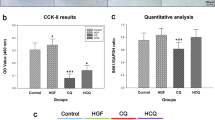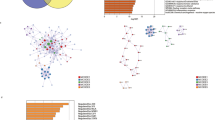Abstract
Objective
To test the role of psoralidin in human liver cancer HepG2 cells in vitro.
Methods
Cell viability was assessed by methylthiazolyldiphenyl-tetrazolum bromide assay and apoptotic cells were labeled by annexin V then sorted by flow cytometry. Protein expressions of caspase-3, caspase-8, caspase-9, Bax, Bid, Bcl-2, Bcl-xL and p53 were examined by western blot while activity of caspase-3, -8 and -9 were also determined.
Results
Psoralidin reduces cell viability greatly in a time dependent manner (64%, 40%, 21%, 12% at 2, 6, 24 and 48 h treatment with 64 μmol/L psoralidin respectively) and up-regulates activities of caspase-3, -8 and -9 in a concentration dependent manner (between 4 to 64 μmol/L). Psoralidin also increases the expression of pro-apoptosis genes Bax, Bid and p53 while decreases the expression of pro-survival genes Bcl-2 and Bcl-xL, both in a concentration dependent manner between 4 and 64 μmol/L (P<0.05 at 16 and 64 μmol/L). Caspase-3 inhibitor (Ac-DEVD-CHO at concentrations between 10 to 20 μmol/L), p53 inhibitor (pifithrin-α at 5 μmol/L) and cyclosporin A can attenuate the apoptotic effect of psoralidin.
Conclusion
The cytotoxic role of psoralidin might work through both intrinsic and extrinsic apoptotic pathway.
Similar content being viewed by others
References
Lim SH, Ha TY, Kim SR, Ahn J, Park HJ, Kim S. Ethanol extract of Psoralea corylifolia L. and its main constituent, bakuchiol, reduce bone loss in ovariectomised Sprague-Dawley rats. Br J Nutr 2009;101:1031–1039.
Wang D, Li F, Jiang Z. Osteoblastic proliferation stimulating activity of Psoralea corylifolia extracts and two of its flavonoids. Planta Med 2001;67:748–749.
Lee SW, Yun BR, Kim MH, Park CS, Lee WS, Oh HM, et al. Phenolic compounds isolated from Psoralea corylifolia inhibit IL-6-induced STAT3 activation. Planta Med 2012;78:903–906.
Chopra B, Dhingra AK. Psoralea corylifolia L. (Buguchi)-folklore to modern evidence: review. Fitoterapia 2013;90:44–56.
Yang YM, Hyun JW, Sung MS, Chung HS, Kim BK, Paik WH, et al. The cytotoxicity of psoralidin from Psoralea corylifolia. Planta Med 1996;62:353–354.
Mar W, Je KH, Seo EK. Cytotoxic constituents of Psoralea corylifolia. Arch Pharm Res 2001;24:211–213.
Szliszka E, Czuba ZP, S dek, Paradysz A, Król W. Enhanced TRAIL-mediated apoptosis in prostate cancer cells by the bioactive compounds neobavaisoflavone and psoralidin isolated from Psoralea corylifolia. Pharmacol Rep 2011;63:139–148.
Bronikowska J, Szliszka E, Jaworska D, Czuba ZP, Krol W. The coumarin psoralidin enhances anticancer effect of tumor necrosis factor-related apoptosis-inducing ligand (TRAIL). Molecules 2012;17:6449–6464.
Das TP, Suman S, Damodaran C. Induction of reactive oxygen species generation inhibits epithelial-mesenchymal transition and promotes growth arrest in prostate cancer cells. Mol Carcinog 2014;53:537–547.
Kumar R, Srinivasan S, Pahari P, Rohr J, Damodaran C. Activating stress-activated protein kinase-mediated cell death and inhibiting epidermal growth factor receptor signaling: a promising therapeutic strategy for prostate cancer. Mol Cancer Ther 2010;9:2488–2496.
Srinivasan S, Kumar R, Koduru S, Chandramouli A, Damodaran C. Inhibiting TNF-mediated signaling: a novel therapeutic paradigm for androgen independent prostate cancer. Apoptosis 2010;15:153–161.
Kerr JF, Wyllie AH, Currie AR. Apoptosis: a basic biological phenomenon with wide-ranging implications in tissue kinetics. Br J Cancer 197;26:239-257.
Woo M, Hakem R, Mak TW. Executionary pathway for apoptosis: lessons from mutant mice. Cell Res 2000;10:267–278.
Wei MC, Zong WX, Cheng EH, Lindsten T, Panoutsakopoulou V, Ross AJ, et al. Proapoptotic Bax and Bak: a requisite gateway to mitochondrial dysfunction and death. Science 2001;292:727–730.
Youle RJ, Strasser A. The Bcl-2 protein family: opposing activities that mediate cell death. Nat Rev Mol Cell Biol 2008;9:47–59.
Guicciardi ME, Gores GJ. Life and death by death receptors. FASEB J 2009;23:1625–1637.
Oberst A, Pop C, Tremblay AG, Blais V, Denault JB, Salvesen GS, et al. Inducible dimerization and inducible cleavage reveal a requirement for both processes in caspase-8 activation. J Biol Chem 2010;285:16632–16642.
Luo X, Budihardjo I, Zou H, Slaughter C, Wang X. Bid, a Bcl-2 interacting protein, mediates cytochrome C release from mitochondria in response to activation of cell surface death receptors. Cell 1998;94:481–490.
Li H, Zhu H, Xu CJ, Yuan J. Cleavage of Bid by caspase 8 mediates the mitochondrial damage in the Fas pathway of apoptosis. Cell 1998;94:491–501.
Youle RJ, Strasser A. The Bcl-2 protein family: opposing activities that mediate cell death. Nat Rev Mol Cell Biol 2008;9:47–59.
Wang K, Yin XM, Chao DT, Milliman CL, Korsmeyer SJ. Bid: a novel BH3 domain-only death agonist. Genes Dev 1996;10:2859–2869.
Luo X, Budihardjo I, Zou H, Slaughter C, Wang X. Bid, a Bcl-2 interacting protein, mediates cytochrome C release from mitochondria in response to activation of cell surface death receptors. Cell 1998;94:481–490.
Li H, Zhu H, Xu CJ, Yuan J. Cleavage of Bid by caspase 8 mediates the mitochondrial damage in the Fas pathway of apoptosis. Cell 1998;94:491–501.
Korsmeyer SJ, Wei MC, Saito M, Weiler S, Oh KJ, Schlesinger PH. Pro-apoptotic cascade activates Bid, which oligomerizes Bak or Bax into pores that result in the release of cytochrome c. Cell Death Differ 2000;7:1166–1173.
Simón R, Aparicio R, Housden BE, Bray S, Busturia A. Drosophila p53 controls Notch expression and balances apoptosis and proliferation. Apoptosis 2014;19:1430–1443.
Mollereau B, Perez-Garijo A, Bergmann A, Miura M, Gerlitz O, Ryoo HD, et al. Compensatory proliferation and apoptosis-induced proliferation: a need for clarification. Cell Death Differ 2013;20:181.
Ryoo HD, Bergmann A. The role of apoptosis-induced proliferation for regeneration and cancer. Cold Spring Harb Perspect Biol 2012;4:a008797.
Chung CS, Venet F, Chen Y, Jones LN, Wilson DC, Ayala CA, et al. Deficiency of Bid protein reduces sepsis-induced apoptosis and inflammation, while improving septic survival. Shock 2010;34:150–161.
Amaral JD, Xavier JM, Steer CJ, Rodrigues CM. The role of p53 in apoptosis. Discov Med 2010; 9:145–152.
Chiou WF, Don MJ, Liao JF, Wei BL. Psoralidin inhibits LPSinduced iNOS expression via repressing SYK-mediated activation of PI3K-IKK-IB signaling pathways. Eur J Pharmacol 2011;650:102–109.
Lee SJ, Nam KW, Mar W. Induction of quinone reductase activity by psoralidin isolated from Psoralea corylifolia in mouse hepa 1c1c7 cells. Arch Pharm Res 2009;32:1061–1065.
Siemankowski LM, Morreale J, Butts BD, Briehl MM. Increased tumor necrosis factor-alpha sensitivity of MCF-7 cells transfected with NAD(P)H:quinone reductase. Cancer Res 2000;60:3638–3644.
Yang HJ, Youn H, Seong KM, Yun YJ, Kim W, Kim YH, et al. Psoralidin, a dual inhibitor of COX-2 and 5-LOX, regulates ionizing radiation (IR)-induced pulmonary inflammation. Biochem Pharmacol 2011;82:524–534.
Shan C, Xu F, Zhang S, You J, You X, Qiu L, et al. Hepatitis B virus X protein promotes liver cell proliferation via a positive cascade loop involving arachidonic acid metabolism and p-ERK1/2. Cell Res 2010;20:563–575.
Ponticelli C. Cyclosporine: from renal transplantation to autoimmune diseases. Ann N Y Acad Sci 2005;1051:551–558.
Gisslinger H, Burghuber OC, Stacher G, Schwarz W, Punzengruber C, Graninger W, et al. Efficacy of cyclosporin A in systemic sclerosis. Clin Exp Rheumatol 1991;9: 383–390.
Ling X, Zhou Y, Li SW, Yan B, Wen L. Modulation of mitochondrial permeability transition pore affects multidrug resistance in human hepatocellular carcinoma cells. Int J Biol Sci 2010;6:773–783.
Ma S, Liu P, Li Y, Hou L, Chen L, Qin C. Cyclosporine A inhibits apoptosis of rat gingival epithelium. J Periodontol 2013;85:1126–1134.
Author information
Authors and Affiliations
Contributions
Yu B and Zhou K designed the experiments; Wang AH, Zhou K, Chai LJ and Liu L performed the experiments; Yu B, Wang AH and Zhou K analyzed data; Yu B and Zhou K drafted manuscript.
Corresponding author
Additional information
Supported by the National Natural Science Foundation of China (No. 81202991) and Tianjin City Application Basis, Cutting-edge Technology Research Program (Tianjin Municipal Science and Technology Commission, No. 13JCYBJC38500)
Rights and permissions
About this article
Cite this article
Yu, B., Wang, Ah., Zhou, K. et al. Molecular Pathway of Psoralidin-Induced Apoptosis in HepG2 Cell Line. Chin. J. Integr. Med. 25, 757–762 (2019). https://doi.org/10.1007/s11655-016-2251-5
Accepted:
Published:
Issue Date:
DOI: https://doi.org/10.1007/s11655-016-2251-5




